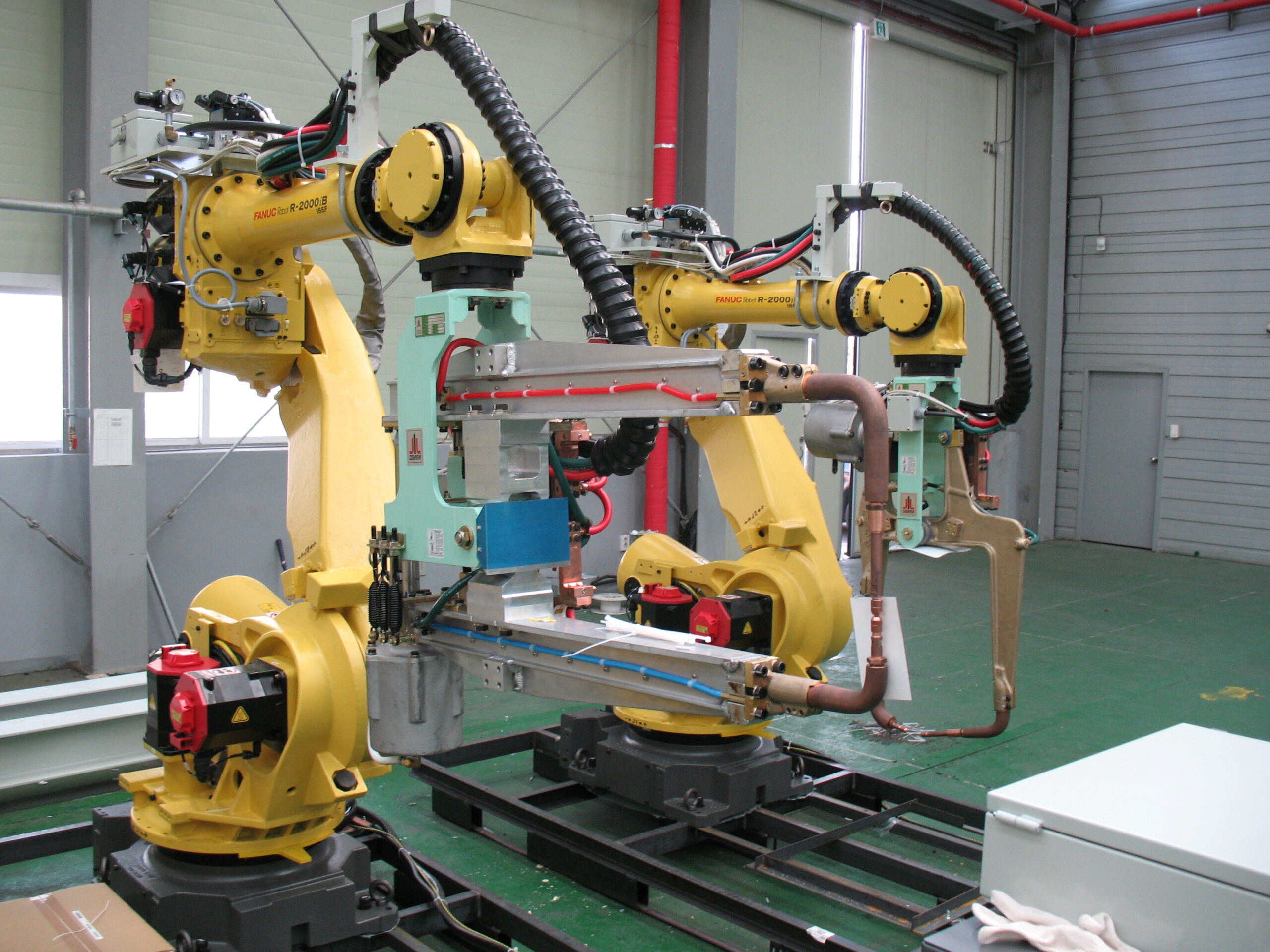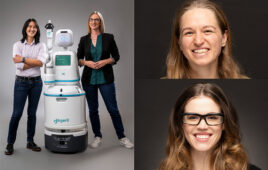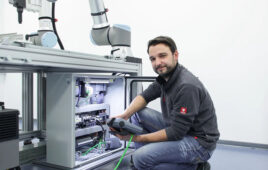Cloud robotics brings the power of cloud computing to management of industrial automation, particularly machine tending. This technology is evolving along with IoT and AI, and Tend.ai is working with major collaborative robot vendors.

Cloud robotics is an area that is quickly evolving. As the underlying technology matures, commercial applications for cloud robotics are now coming to market and simplifying the task of managing a fleet of robots on the manufacturing floor.
Let’s take a closer look at cloud robotics, including the offerings of new vendor in this space, Tend.ai.
[note style=”success” show_icon=”false”]Business Takeaways:
- Tend.ai, a human-machine interface innovator, is using the cloud to enable operators to remotely monitor and operate robotic systems.
- Tend is also lowering the knowledge bar and the costs associated with learning how to set up various robots. A unified programming language and command-and-control interface simplify the management of an automated workforce.
- Cloud robotics is now a safe way to share data from the manufacturing floor.
Defining cloud robotics
“Cloud robotics and automation systems can be broadly defined as any robot or automation system that relies on data or code from a network to support its operation, i.e., where not all sensing, computation, and memory is integrated into a single standalone system,” according to Ken Goldberg, robotics professor at the University of California, Berkeley.
One characteristic of cloud robotics is that data travels bi-directionally between a remote user and a local system via the Internet. This functionality enables the user to remotely tele-operate the device, be instantly alerted to error conditions, and recover the system without having to be physically present.
The decisions made by a cloud robotics system can also be enhanced by the processing power inherent in the cloud. The cloud provides virtually unlimited data-storage capability. This big data in turn enables the components operating locally on the robot to be less expensive.

The Ars Electronica Museum’s “TeleGarden” experiment involved the Internet.
Ken Goldberg and Joseph Santarromana were the first people to connect a robot to the Internet, allowing remote users to interact with the machine. In their famous “TeleGarden” experiment in 1995, Internet users could log into the robot, water their plants, and watch them grow remotely.
A second key feature of cloud robotics is the ability of networked systems to share data including program updates and process knowledge. With the advent of artificial intelligence to process the collective data, the entire system can benefit from shared improvements.
Self-driving cars can be included among cloud-based systems in this context. Autonomous vehicles can use and share a data set of road conditions, live traffic updates, and weather reports to plan safe routes on public roads. This architecture enables the vehicle system to continue to operate locally (within the vehicle) in the case network access is lost.
Protecting safety and security
Safety should be paramount for any cloud robotics. Features such as real-time motion control and the handling of emergency stops will always require some element of local processing and I/O. Sharing information such as production data, 3D shape data, images, and other large data sets is perfect for a cloud-based architecture.
On the manufacturing floor or in warehouses, any cloud robotics solution will have to be designed so that low-level functions of real-time control will be delegated to the robot controller.
Meanwhile, mid-level processing functions such as sequencing can be delegated to local supervisory systems. High-level functions like statistical process control (SPC), reporting, and error handling can be pushed to the cloud for consolidation across the entire production plant.

Network security is also key to any cloud robotics. Any architecture must prevent unwanted access to the data crossing the Internet while also controlling access to to prevent malevolent activities with the robot system.
The good news is that the evolution of network security in the IT space over the past 10 years has set the standard. There are now protocols and standards to provide security on the manufacturing floor that’s on par with that of corporate IT systems.
AI provides processing horsepower
Today, machine learning algorithms require the processing horsepower of the cloud to effectively process the large data sets generated by multiple mobile sensors in robots. Software is rapidly evolving, and AI is beginning to learn and reason in ways that only humans could do so in the past.
AI will continue to be a part of the cloud robotics story and architecture as this market evolves. Note, however, that many marketing departments are hyping simple supervisory controls on their machines as AI. It’s just not possible to run sophisticated algorithms on the processors commonly used in robot controllers today.
Convergence and IIoT
Several technological and market trends are converging, enabling cloud robotics to spread. The first one is the Industrial Internet of Things (IIoT), which is evolving quickly as standards emerge for network access to every type of controller, sensor, camera and intelligent device on the manufacturing floor.
The goal with IIoT is to develop protocols by which devices can be connected to the network, remain secure, and share data with any other device on the network. The idea of a completely connected manufacturing plant has been a dream of production managers for a long time.
Where IIoT looks to the implementation of device-to-device communication, Industry 4.0 is an approach to higher-level processes on the manufacturing floor. What IIoT does for devices, Industry 4.0 does for production supervisors.
Tend.ai combines the cloud and cobots
Tend.ai has brought to market one of the first innovations in leveraging the cloud to connect factory automation. As the company name implies, Tend is initially focusing on improving machine tending, which is now being automated though the application of collaborative robots.
Cobots are designed to operate safely next to humans without the need for expensive and constraining safety precautions. Cobots are also designed to be quickly reprogrammed, operated, and redeployed on the manufacturing floor as needed.
Tend.ai’s Sidekick combines several state-of-the-art technologies in a unit next to each cobot that it supervises. Sidekick talks directly to the robot controller inside the local network and then effectively operates as a secure gateway to the cloud on the public side of the network.
This architecture ensures that information flowing to and from the cloud is encrypted, preventing any unauthorized access to the local robot. Each Sidekick runs program code designed to talk to the specific robot vendor with which it is partnered.
Tend’s virtual machine operator
In addition, an inexpensive camera can connect the cobot and Sidekick. This allows the Tend system to use human-machine interfaces (HMI) on machine tools.
With this capability, a Tend-enabled robot can view an HMI and press buttons on the process tool as a human operator would. This functionality can be used to initiate or stop a process, all without the need for local human interaction.
Furthermore, the Tend system can take the information seen on the process machine HMI and remotely alert an operator on his or her phone or tablet through the cloud. The operator can then instruct the robot how to recover from the situation without having to be near the machine. Or, the robot can be programmed to respond automatically.
[note style=”success” show_icon=”true”]More on Tend.ai:
Tend will be discussing its offerings at some upcoming events:
- PTC LiveWorx 2017, May 22-25, 2017, Boston
- RoboBusiness 2017, Sept. 27-28, 2017, Santa Clara, Calif.
The universal language of robots
Most significantly, operators can quickly and easily train Tend-enabled robots via a phone or tablet. The Tend programming interface simplifies the management of various systems because the operator doesn’t need to understand the unique programming characteristics of each robot.
Cloud robot applications
Machine tending is the natural and initial application for Tend.ai’s products. This includes loading and unloading of CNC tools or 3D printers.
In addition, cloud robotics can enable cobots to make visual inspections for quality control. With the use of a camera attached to the cobot, Tend’s system can move the camera to inspect an assembly or completed component and then make a decision based on that information.
Cloud processing expands the capabilities of collaborative robots and simplifies remote operations. Tend.ai’s systems can work with industrial automation from market leaders such as FANUC, Rethink Robotics, and Universal Robots. The company said its product roadmap will extend to other robot manufacturers over time.
[note style=”success” show_icon=”true”]
More on Cloud Robotics and Manufacturing:
- Five Autonomous Systems Takeaways From Xponential Day 1
- Mobile Robots, Cobots Steal the Show at Automate, ProMat 2017
- Human-Robot Interfaces Should Be Subject to Legal Protection
- Five Facts From 2016’s Top Robotics Conference Every Business Must Know
- Cloud Robotics Will Lead to General-Purpose Robots, Says Toyota’s Kuffner
- Home Hunting for Collaborative Bots: Farm, Cloud, or Back Office?
- Arise Rapyuta: Cloud Engine for Robots Goes Live
- Is IBM Leading the Next (Virtual) Step in Cloud Robotics?
- The Age of Cloud Robotics Approaches
From dreams to reality
Cloud robotics is quickly moving from being a buzzword to being part of real-life applications. Robot suppliers are working to mitigate security risks as they develop an architecture that includes all of the advantages of the Internet and cloud computing.




